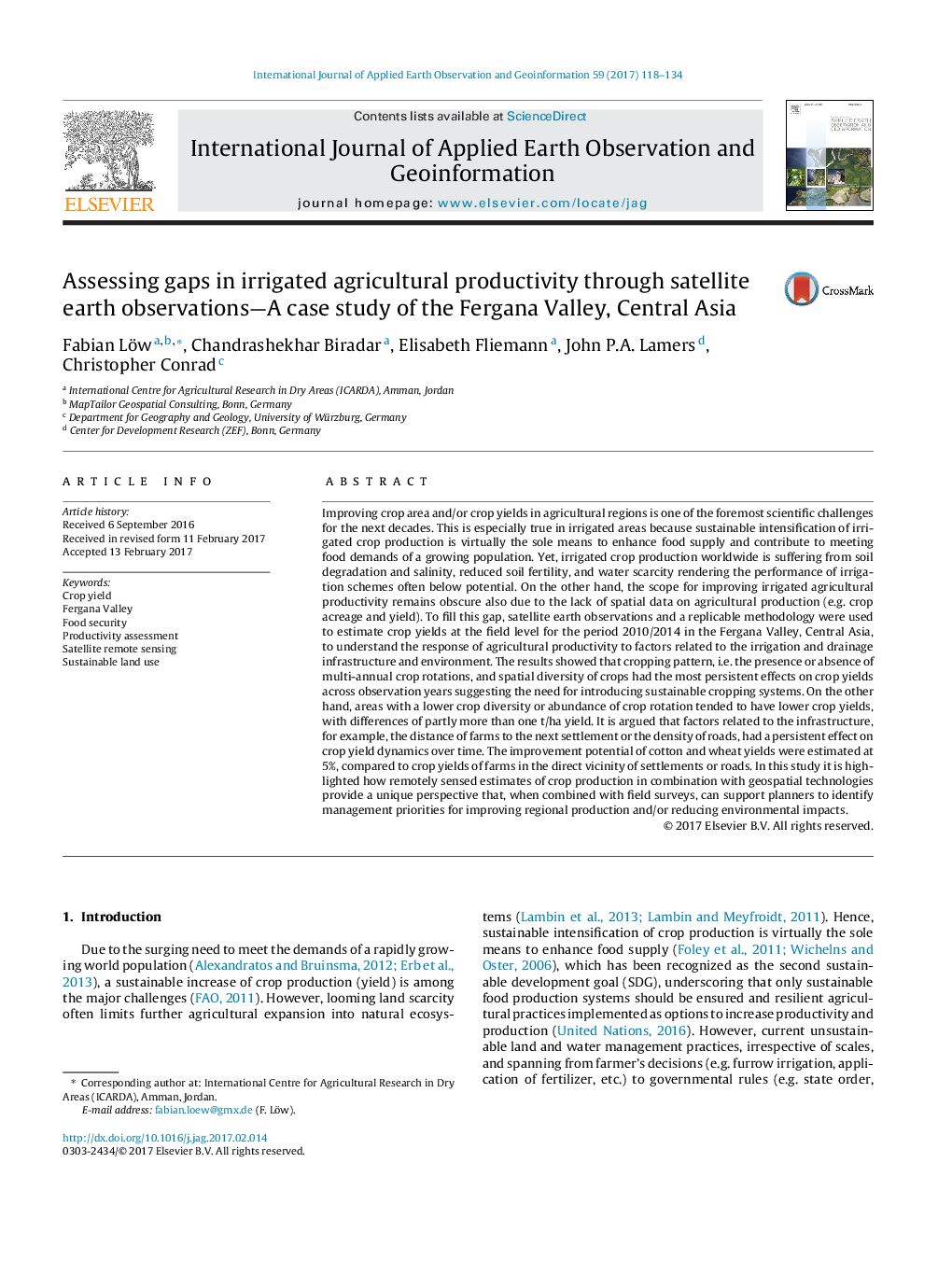| کد مقاله | کد نشریه | سال انتشار | مقاله انگلیسی | نسخه تمام متن |
|---|---|---|---|---|
| 5755607 | 1621798 | 2017 | 17 صفحه PDF | دانلود رایگان |
عنوان انگلیسی مقاله ISI
Assessing gaps in irrigated agricultural productivity through satellite earth observations-A case study of the Fergana Valley, Central Asia
ترجمه فارسی عنوان
بررسی شکاف در بهره وری کشاورزی آبی با استفاده از مشاهدات ماهواره ای ماهواره ای - مطالعه موردی دره فرغانه، آسیای مرکزی
دانلود مقاله + سفارش ترجمه
دانلود مقاله ISI انگلیسی
رایگان برای ایرانیان
کلمات کلیدی
بازده محصول، دره فرغانه، امنیت غذایی، ارزیابی بهره وری، سنجش از راه دور ماهواره، استفاده پایدار از زمین،
ترجمه چکیده
بهبود بخش زراعت و / یا عملکرد محصول در مناطق کشاورزی یکی از مهمترین چالش های علمی برای دهه های آینده است. این به ویژه در مناطق آبیاری درست است، زیرا تشدید پایدار تولید محصول آبیاری عملا تنها وسیله برای افزایش عرضه مواد غذایی و کمک به رفع نیازهای غذایی جمعیت رو به رشد است. با این حال، تولید محصول آبی در سراسر جهان از تخریب خاک و شوری رنج می برد، کاهش بارندگی خاک و کمبود آب را نشان می دهد که عملکرد طرح های آبیاری اغلب کمتر از توان بالقوه است. از سوی دیگر، دامنه برای بهبود بهره وری کشاورزی آبی همچنان مبهم است به دلیل کمبود داده های مکانی در تولید محصولات کشاورزی (مانند زمین های زراعی و عملکرد). برای پر کردن این شکاف، مشاهدات ماهواره ای ماهواره ای و یک روش تکرارپذیر برای ارزیابی عملکرد محصول در سطح منطقه برای دوره 2010/2014 در دره فرغانه، آسیای مرکزی، برای درک پاسخ بهره وری کشاورزی به عوامل مرتبط با آبیاری و زیرساخت زهکشی و محیط زیست. نتایج نشان داد که الگوی کاشت، یعنی وجود یا عدم وجود چرخش های چند ساله و تنوع محیطی، بیشترین تأثیر را بر تولید محصول در سال های مشاهده دارد که نشان دهنده نیاز به معرفی سیستم های کشت پایدار است. از سوی دیگر، مناطقی با تنوع زیستی پایینتر یا فراوانی از سوی گیاهان دارویی دارای عملکرد پایین محصولات زراعی بودند، که تفاوت آنها تا حدی بیشتر از یک تن در هکتار بود. استدلال می شود که عوامل مرتبط با زیرساخت ها، به عنوان مثال، فاصله مزارع تا محل سکونت بعدی و یا تراکم جاده ها، تأثیر مداوم بر پویایی عملکرد محصول در طول زمان داشته است. پتانسیل بهبود تولید پنبه و گندم در مقایسه با تولید محصول مزارع در نزدیکی شهرک ها یا جاده ها 5٪ تخمین زده شد. در این مطالعه مشخص شده است که برآورد های از راه دور محصول کاشت در ترکیب با فناوری های جغرافیایی چشم انداز منحصر به فردی را ارائه می دهد که با ترکیب مطالعات میدانی می تواند از برنامه ریزان برای شناسایی اولویت های مدیریت برای بهبود تولید منطقه و / یا کاهش اثرات زیست محیطی پشتیبانی کند.
موضوعات مرتبط
مهندسی و علوم پایه
علوم زمین و سیارات
کامپیوتر در علوم زمین
چکیده انگلیسی
Improving crop area and/or crop yields in agricultural regions is one of the foremost scientific challenges for the next decades. This is especially true in irrigated areas because sustainable intensification of irrigated crop production is virtually the sole means to enhance food supply and contribute to meeting food demands of a growing population. Yet, irrigated crop production worldwide is suffering from soil degradation and salinity, reduced soil fertility, and water scarcity rendering the performance of irrigation schemes often below potential. On the other hand, the scope for improving irrigated agricultural productivity remains obscure also due to the lack of spatial data on agricultural production (e.g. crop acreage and yield). To fill this gap, satellite earth observations and a replicable methodology were used to estimate crop yields at the field level for the period 2010/2014 in the Fergana Valley, Central Asia, to understand the response of agricultural productivity to factors related to the irrigation and drainage infrastructure and environment. The results showed that cropping pattern, i.e. the presence or absence of multi-annual crop rotations, and spatial diversity of crops had the most persistent effects on crop yields across observation years suggesting the need for introducing sustainable cropping systems. On the other hand, areas with a lower crop diversity or abundance of crop rotation tended to have lower crop yields, with differences of partly more than one t/ha yield. It is argued that factors related to the infrastructure, for example, the distance of farms to the next settlement or the density of roads, had a persistent effect on crop yield dynamics over time. The improvement potential of cotton and wheat yields were estimated at 5%, compared to crop yields of farms in the direct vicinity of settlements or roads. In this study it is highlighted how remotely sensed estimates of crop production in combination with geospatial technologies provide a unique perspective that, when combined with field surveys, can support planners to identify management priorities for improving regional production and/or reducing environmental impacts.
ناشر
Database: Elsevier - ScienceDirect (ساینس دایرکت)
Journal: International Journal of Applied Earth Observation and Geoinformation - Volume 59, July 2017, Pages 118-134
Journal: International Journal of Applied Earth Observation and Geoinformation - Volume 59, July 2017, Pages 118-134
نویسندگان
Fabian Löw, Chandrashekhar Biradar, Elisabeth Fliemann, John P.A. Lamers, Christopher Conrad,
